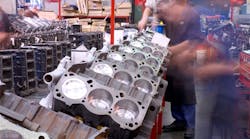The share of American workers belonging to labor unions held steady in 2017, matching the historic low of 10.7% set in the prior year, according to a Labor Department report Friday.
The membership rate for wage and salary employees is down from 20.1% in 1983, when the government began tracking comparable data, and from more than one-third of workers in the 1950s, according to separate figures looking further back.
While the nation’s total employment of wage and salary workers rose by 1.8 million last year, the number of union members increased by just 262,000, to 14.8 million. That’s down from 17.7 million union workers in 1983.
The percentage of government employees in unions, though steady from the prior year at 34.4%, continued to be more than five times the 6.5% rate for private sector workers.
The percentage of manufacturing industry (durable and non-durable goods) workers in unions edged up to 9.1% in 2017 from 8.8% in 2016, according to Labor Department data. Production occupations in unions were reported at 12.4% in 2017, compared with 11.8% in the previous year.
Among states, South Carolina continued to have the lowest unionization rate, 2.6%, followed by North Carolina at 3.4%. New York had the highest, 23.8%, with Hawaii second, at 21.3%.
Median weekly earnings of union members continued to be higher than those of comparable nonunion workers in both the government ($1,104 vs. $917) and private sector ($984 vs. $816), the data showed.
Richard Trumka, president of the AFL-CIO, put a positive spin on the data, saying the increase in the number of union members reflects “critical organizing victories across a range of industries.” Beyond the numbers lies a “growing movement of working people that can’t be measured as easily,” he said in a statement.
By Jordan Yadoo
IndustryWeek contributed the manufacturing-related data to this article.



